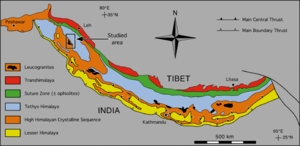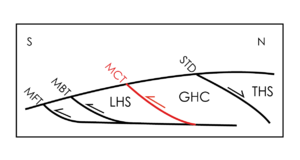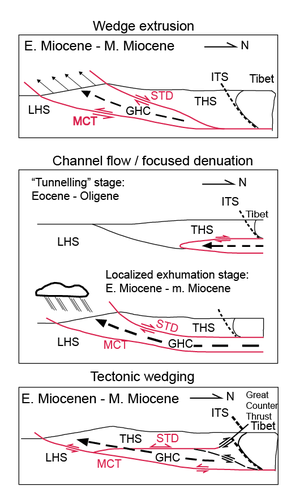Main Central Thrust
| Wiki Write-Off Entry | |
|---|---|

| |
| Student Chapter | Louisiana State University |
| Competition | December 2014 |
The Main Central Thrust is one of the north-dipping and NW—SE strike thrust faults along the Himalaya[1]. Generally speaking, the Main Central Thrust is the ductile shear zone, along which the Great Himalayan Crystalline complex was placed over the Lesser Himalayan Sequence.[2]

Geologic background
The Himalayan orogen is the production of the collision between continents of India and Asia. It is structurally dominated by three north-dipping, fault—bound units stacked by, from north to south, the Southern Tibetan Detachment, the Main Central Thrust, the Main Boundary Thrust and the Main Frontal Thrust[2]. These units, from south to north, are:
- The Lesser Himalayan Sequence (LHS), mainly low-grade Proterozoic metasediments to unmetamorphosed rocks, which is bound above by the Main Central Thrust.
- The Greater Himalayan Crystalline complex (GHC), mainly high-grade gneiss and migmatite, which is bound below and above by the Main Central Thrust and the Southern Tibetan Detachment, respectively
- The Tethyan Himalayan Sequence (THS), mainly Proterozoic to Eocene sediments. deformed in an Paleogene fold-thrust belt.[4]
See Figure 2 for the structural relationships between rock units and faults.

Kinematic models
To better understand the position and role of the Main Central Thrust, we should point out the kinematic models of Himalayan Orogen. Generally, there are three kinematic models for the emplacement of the Greater Himalayan Crystalline complex above the Main Central Thrust[5] shown in Figure 3.

- Wedge extrusion mode
- Channel flow-focused denudation involve extrusion of the Greater Himalayan Crystalline complex to the surface between two surface-breaching faults[4][6][7]
- Tectonic wedging model shows emplacement of Greater Himalayan Crystalline complex with the two faults merging to the south[8].
Various definitions of the Main Central Thrust
The difficulties in understanding the Main Central Thrust
Although the general definition of the Main Central Thrust has been given, it is not enough due to the complication and difficulties in defining the Main Central Thrust.
For long, many researchers have defined the Main Central Thrust by different criteria, including by lithology different between the hanging wall and the footwall, by metamorphic grade change from the hangingwall to the footwall, by the different U—Pb detrital zircon ages, by the different Nd isotope compositions, by the different strain, etc. Some of these criteria has also been combined. However, none of these criteria can be reliable if they are used independently[9]. Meanwhile, these criteria cannot all be satisfied neither[10]. The most dominating problems are:
- the lithology and stratigraphy have not been completely investigated and understood
- the metamorphic grades across the Main Central Thrust shear zone are continuously changing, thus any one particular isograd is not reliable for determining the location of the Main Central Thrust
Definition of the Main Central Thrust by various criteria
Despite the above difficulties in defining the Main Central Thrust, the following definitions of the Main Central Thrust have been made by various criteria:
- by lithologic criterion, the Main Central Thrust is defined as the boundary between the quartzite and phyllite, which belong to the Lesser Himalayan Sequence, and the orthogneiss biotite-rich schist, which belong to the Greater Himalayan Crystalline complex[2][11].
- by metamorphic isograd, the Main Central Thrust follows the kyanite isograd. Under this criterion, the crystals of kyanite appears upward only within several meters of the lithologic change stated in the above[12].
- by the differences in U—Pb detrital zircon ages, 1.87-1.0 Ga zircons have been reported from the Lesser Himalayan Sequence which is bound above by the Main Central Thrust, and 0.8-1.0 Ga zircons have been reported from the Greater Himalayan Sequence which is bound below by the Main Central Thrust[13].
- by the Nd isotope composition, different Nd composition (for example, an average Nd value of -21.5 has been reported in the Lesser Himalayan Sequence while an average Nd value of -16 has been reported in the Greater Himalayan Sequence) marks the Main Central Thrust[14].
- by strain, the Main Central Thrust is defined as a broad zone which a few kilometers thick. This zone accommodated most of the ductile shear zones and brittle thrust faults between the lowermost part of the Greater Himalayan Crystalline complex and the uppermost part of the Lesser Himalayan Sequence[9][15].
Prospect
None of the above definitions is precise or reliable because the Main Central Thrust developed and changes its style not only vertically but also along its strike, and even through time. To better understand the Main Central Thrust, more research should be done along its strike and through time and its definition should not be limited to one thrust fault, but should be a broader fault zone and even regarded as a series of faults developed at different times.[10]
References
- ↑ Upreti, B. N., 1999, An overview of the stratigraphy and tectonics of the Nepal Himalaya: Journal of Asian Earth Sciences, vol. 17.5, pp. 577-606.
- ↑ 2.0 2.1 2.2 Helm, A., and A. Gansser, 1939, Central Himalaya, Geological observations of the Swiss expedition: Memoires de la Societe Helvetique des Sciences Naturelles, vol. 73.1, p. 245.
- ↑ Dèzes, Pierre, and Albrecht Steck. "Tectonic and metamorphic evolution of the central Himalayan domain in southeast Zanskar (Kashmir, India)." (1999).
- ↑ 4.0 4.1 Webb, A. A. G., 2013, Preliminary balanced palinspastic reconstruction of Cenozoic deformation across the Himachal Himalaya (northwestern India: Geosphere, vol. 9.3, pp. 572-587.
- ↑ A. A. G. Webb, A. Yin, T. M. Harrison, J. Célérier, G. E. Gehrels, C. E. Manning, and M. Grove, 2011, Cenozoic tectonic history of the Himachal Himalaya (northwestern India) and its constraints on the formation mechanism of the Himalayan orogen: Geosphere, vol. 7.4, pp. 1013-1061.
- ↑ Burchfiel, B. C., and L. H. Royden, 1985, North-south extension within the convergent Himalayan region: Geology vol. 13.10, pp. 679-682.
- ↑ Beaumont, C., R. A. Jamieson, M. H. Nguyen, and B. Lee, 2001, Himalayan tectonics explained by extrusion of a low-viscosity crustal channel coupled to focused surface denudation: Nature, vol. 414, pp. 738-742.
- ↑ Webb, A. A. G., A. Yin, T. M. Harrison, J. Célérier, W. P. Burgess, 2007, The leading edge of the Greater Himalayan Crystalline complex revealed in the NW Indian Himalaya: Implications for the evolution of the Himalayan orogen: Geology, vol. 35.10, pp. 955-958.
- ↑ 9.0 9.1 Searle, M. P., R. D. Law, L. Godin, K. P. Larson, M. J. Streule, J. M. Cottle & M. J. Jessup, 2008, Defining the Himalayan main central thrust in Nepal: Journal of the Geological Society, vol. 165.2, pp. 523-534.
- ↑ 10.0 10.1 Yin, A., 2006, Cenozoic tectonic evolution of the Himalayan orogen as constrained by along-strike variation of structural geometry, exhumation history, and foreland sedimentation: Earth-Science Reviews, vol. 76.1, pp. 1-131.
- ↑ Daniel, C. G., L. S. Hollister, R. R. Parrish, and D. Grujic, 2003, Exhumation of the Main Central Thrust from lower crustal depths, eastern Bhutan Himalaya: Journal of Metamorphic Geology, vol. 21.4, pp. 317-334.
- ↑ Le Fort, P., 1975, Himalayas: the collided range. Present knowledge of the continental arcL Am. J. Sci, vol. 275.1, pp. 1-44.
- ↑ Parrish, R. R., and V. Hodges, 1996, Isotopic constraints on the age and provenance of the Lesser and Greater Himalayan sequences, Nepalese Himalaya: Geological Society of America Bulletin, vol. 108.7, pp. 904-911.
- ↑ Robinson, D. M., P. G. DeCellesa, P. J. Patchetta, and C. N. Garzione, 2001, The kinematic evolution of the Nepalese Himalaya interpreted from Nd isotopes: Earth and Planetary Science Letters, vol. 192.4, pp. 507-521.
- ↑ Searle, M. P., R. L. Simpson, R. D. Law, R. R. Parrish & D. J. Waters, 2003, The structural geometry, metamorphic and magmatic evolution of the Everest massif, High Himalaya of Nepal–South Tibet: Journal of the Geological Society, vol. 160.3, pp. 345-366.